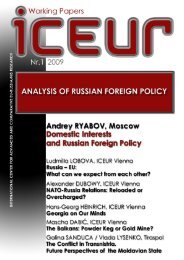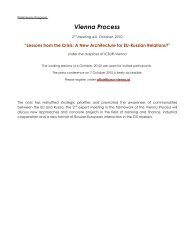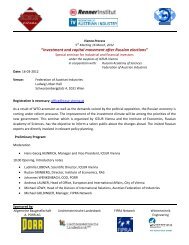Address - International Center for Advanced and Comparative EU ...
Address - International Center for Advanced and Comparative EU ...
Address - International Center for Advanced and Comparative EU ...
You also want an ePaper? Increase the reach of your titles
YUMPU automatically turns print PDFs into web optimized ePapers that Google loves.
Alex<strong>and</strong>er DYNKIN<br />
Global Turmoil: Challenges <strong>for</strong> Russia<br />
professionals were fully aware that the Russian stock market is rather shallow: the bulk of its value is set up<br />
by the shares of 15 – 20 blue chips, predominantly from mining <strong>and</strong> quarrying. No more than 15% of shares<br />
of each company are freely floating. Such markets are notable <strong>for</strong> high volatility. Capital massively rushes to<br />
such markets in the time of boom <strong>and</strong> no less rapidly flows out when problems start. It is interesting that the<br />
number of individual investors at the Russian stock market amounts to 850 thous<strong>and</strong> people. For<br />
comparison, in China, as many as 100 million people are investors.<br />
Finally, thirdly, Russian companies appeared to be very much over-indebted. They have accumulated<br />
<strong>for</strong>eign credit of as much as 600 billion dollars. When the price of loans or the value of money sharply<br />
increased, Russian companies faced margin calls <strong>and</strong> rushed to the Government <strong>for</strong> support. Of course,<br />
massive borrowing abroad has been partly <strong>for</strong>ced by the rigid credit <strong>and</strong> monetary politics in the country<br />
over the last years (see Schedule 2).<br />
Why has the 2008-2009 Credit Crunch<br />
seriously affected Russia<br />
1.<br />
2.<br />
3.<br />
4.<br />
A high share of <strong>for</strong>eign capital in the Russian stock market has resulted in a more than<br />
four-fold meltdown<br />
Heavy debt incurred by Russian companies to <strong>for</strong>eign investors - up to US$ 500 billion.<br />
US$160 are to be returned to creditors by the end of 2009<br />
Dependence of social <strong>and</strong> economic development <strong>and</strong> national budget income on<br />
export oil prices. In the second haft of 2008 oil price fell from US$140 to US$34-35 per<br />
barrel (Urals). Oil price less than US$60-70 per barrel (in 2009) would result in a budget<br />
deficit up to US$80 billion.<br />
A maximum reduction of the liquidity of Russian banks <strong>and</strong> companies on the eve of the<br />
crisis due to the Russian Central Bank’s anti inflation policy(tightening the money supply)<br />
5.<br />
Excessive budgetary expenditures due to the huge inflow of <strong>for</strong>eign currency in 2003-<br />
2007 <strong>and</strong> the first half of 2008 as well as high social <strong>and</strong> economic commitments made<br />
by the government<br />
6.<br />
Law adaptation capabilities of industry<br />
Schedule 2<br />
Trying to neutralize these problems during the last 6 months, the Central Bank sold $210 billion of<br />
international reserves. Approximately 60% of this sum represents capital outflow. Substantial amounts of<br />
<strong>for</strong>eign currency were bought by domestic banks, non-financial sector companies <strong>and</strong> households. The raids<br />
of customers on the banks were successfully managed, though this threat was imminent <strong>for</strong> a short period in<br />
October, when the Ruble drastically went down.<br />
The stock prices dropped by 80%. The Ruble has depreciated against the dollar since July 2008 by 60%. The<br />
recent GDP rate of growth <strong>for</strong>ecast <strong>for</strong> 2009 is minus 7-8%. Budget revenues, according to the Ministry of<br />
Finance estimates, will fall by up to 40%, <strong>and</strong> the budget deficit will amount to approximately 8%. A decline<br />
of production of up to 20-30% is expected in many sectors, including steel, non-ferrous metals, housing<br />
construction, textiles, retail, <strong>and</strong> bank credits (see Schedule 3).<br />
Unemployment became a very serious problem, exceeding a share of 7% of the economic active population<br />
<strong>and</strong> causing a social conflict situation in some regions, <strong>for</strong> example, in the center of the Russian car industry,<br />
the city of Togliatti, where twenty-five thous<strong>and</strong> employees are endangered by unemployment.<br />
The trade balance is still positive, <strong>and</strong> so is the current balance of payments. A question of crucial importance<br />
<strong>for</strong> Russia is whether financial speculations on oil futures will stop. Generally, at least in Russia, there were<br />
many talks about “the end of the epoch of cheap oil”. Is that true What will the global financial architecture<br />
<strong>and</strong> correspondingly, the security architecture look like Will G-20 countries manage to come to an<br />
agreement <strong>and</strong> what will this consensus look like The summits in Washington <strong>and</strong> London were not very<br />
IC<strong>EU</strong>R-Vienna Working Papers 2|2009 7









